
Stephens City is an incorporated town in the southern part of Frederick County, Virginia, United States, with a population of 2,016 at the time of the 2020 census, and an estimated population of 2,096 in 2022. Founded by Peter Stephens in the 1730s, the colonial town was chartered and named for Lewis Stephens in October 1758. It was originally settled by German Protestants from Heidelberg.

The Sloan–Parker House, also known as the Stone House, Parker Family Residence, or Richard Sloan House, is a late-18th-century stone residence near Junction, Hampshire County, in the U.S. state of West Virginia. It was built on land vacated by the Shawnee after the Native American nation had been violently forced to move west to Kansas following their defeat at the Battle of Point Pleasant in 1774. The building was added to the National Register of Historic Places on June 5, 1975, becoming Hampshire County's first property to be listed on the register. The Sloan–Parker House has been in the Parker family since 1854. The house and its adjacent farm are located along the Northwestern Turnpike in the rural Mill Creek valley.
Bartonsville is an unincorporated community located along Opequon Creek in Frederick County, Virginia between Winchester and Stephens City. Bartonsville is on Springdale Road to the west of Valley Pike. Historically, it has been referred to as Barton's Mill and Bartonville. The area of Bartonsville was first settled by the Hite Family in 1733. During the American Civil War, the village was garrisoned with a small stone fort of unknown location held by the Union Army.
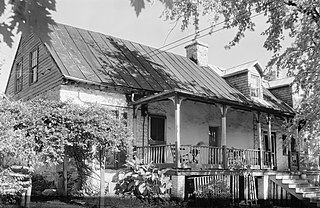
White House Farm, also known as White House Tavern and the Dr. John McCormick House, listed in the National Register of Historic Places, is located in Jefferson County, West Virginia, near the small town of Summit Point, about six miles from Charles Town, West Virginia. The farm consists of a ca. 1740 farmhouse, a stone barn, a springhouse of about the same age, a wooden curing shed, and 60+ acres of pasture and woods. The farm is one of the oldest in the county and has a rich history.
Richard Walker Barton was a nineteenth-century politician, lawyer and planter from Virginia. His nephew Robert Thomas Barton (1842-1917), who unlike three of his brothers survived fighting in the Confederate States Army, also became a distinguished lawyer in the Winchester, Virginia area, as well as a member of the Virginia House of Delegates and author. Career U.S. Army officer turned controversial Confederate engineer Seth Maxwell Barton of Fredericksburg was a more distant relative.

This is a list of the National Register of Historic Places listings in Frederick County, Virginia.

Belle Grove Plantation is a late-18th-century plantation house and estate in the northern Shenandoah Valley of Virginia, USA. It is situated in Frederick County, about a mile southwest of Middletown.
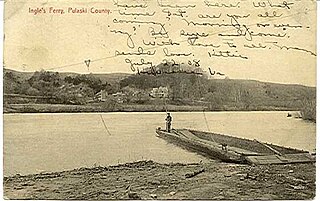
Ingles Ferry is the site of a historic ferry crossing on the New River in western Virginia, near the city of Radford in Pulaski County, Virginia, United States. A tavern was opened there in 1772 and the ferry served soldiers and civilians until 1948. A bridge was built at the site in 1842 but was burned during the civil war. The tavern and replicas of the 18th-century home of the Ingles family can be seen nearby.

Van Metre Ford Stone Bridge is a historic stone arch bridge located near Martinsburg, Berkeley County, West Virginia. Built by Pennsylvania builder Silas Harry, it was built in 1832, and is a three span bridge crossing Opequon Creek. It is 132 feet long and constructed of ashlar limestone. The center span measures 32 feet and the two side spans are each 29.5 feet long.

Hopewell Friends Meeting House is an 18th-century Quaker meeting house located the northern Frederick County, Virginia one mile west of the community of Clear Brook at 604 Hopewell Road. Clear Brook, VA 22624. This community was the home of Thomas William "Tom" Fox (1951–2006), a Quaker peace activist, affiliated with Christian Peacemaker Teams (CPT) murdered in 2006 in Iraq.

Opequon Presbyterian Church is a historic Presbyterian church located near Winchester, in Frederick County, Virginia. It was built in 1897, and is a one-story, gable-roofed, random-rubble stone church. It features Gothic-arched colored-glass, one-over-one windows and a three-stage corner bell tower containing an entrance. Also on the property are four burying grounds with the oldest marked grave site dated to 1742.

D. S. Tavern, also known as the 1740 House, is a historic tavern located at Ivy, Albemarle County, Virginia. The building dates to the late 18th to early 19th century. It is a two-story, single pile, log and frame I-house, covered in beaded weatherboards. It sits on a brick and rubblestone foundation and has a gable roof pierced by two brick chimneys. It has an early-19th-century, one-story kitchen connected by a hyphen. From 1785 to about 1850, the tavern served the westward movement of settlers along the turnpike running from Richmond to the Valley. The tavern was owned by Chief Justice John Marshall, who maintained the property from 1810 to 1813. In the mid- to late 19th century, it was converted to a private residence.

Springdale Mill Complex, also known as Springdale Flour Mill, is a historic grist mill complex located near Bartonsville, Frederick County, Virginia. The mill was built about 1788, and is constructed of coursed rubble limestone with wood-frame end gables. Associated with the mill are a number of outbuildings which were erected in the late 19th and early 20th centuries, a 2+1⁄2-story rubble limestone residence, and a 2+1⁄2-story wood-frame residence.

Opequon Historic District is a national historic district located in Opequon near Winchester, Frederick County, Virginia. It encompasses 33 contributing buildings and 1 contributing site in the village of Opequon. Notable buildings include Race Mills the oldest surviving building in the village, the Glass-Rinker-Cooper Mill, Greenwood, The Millhouse, Homespun (1771), the Hodgson (Bayliss) Store, The Second Opequon Presbyterian Church (1939), Tokes' Inn, and Bleak House.

The Middletown Historic District is a national historic district located in Middletown, Virginia. It originally encompassed 234 contributing properties, the majority of which are residential buildings and their associated outbuildings. The boundaries of the historic district are approximately Church Street, Senseney Avenue, and First through Sixth Streets, except for a portion of Main Street that ends just south of Reliance Road.
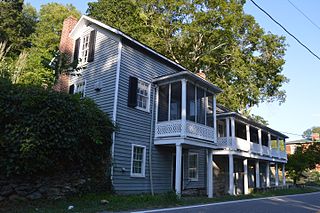
Tankersley Tavern, also known as Old Bridge, is a historic building located near Lexington, Rockbridge County, Virginia. It was built in three sections with the oldest dated to about 1835. It is a two-story, nine-bay, single pile, frame building with an exposed basement and a decorative two-level gallery on the front facade. Also on the property are the contributing washhouse/kitchen, three frame sheds and a stone abutment for a bridge. It was originally built as a toll house at the county end of the bridge crossing the Maury River from the Valley Turnpike into Lexington. It later housed a tavern, canal ticket office, general store, post office, and dwelling.
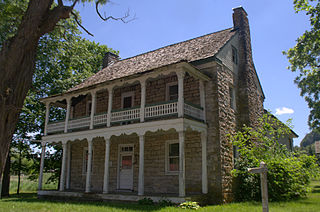
Old Stone Tavern, also known as Rock House, is a historic inn and tavern located near Atkins, Smyth County, Virginia. It was built by Frederick Cullop before 1815, and is a two-story, three-bay, limestone structure with a central-hall plan. A frame rear ell was added in the mid-19th century. It has a side-gable roof. The front facade features a mid-19th-century porch supported by chamfered columns connected on each level by a decorative cyma frieze and sawn balustrade. The tavern was built to accommodate travelers in the heavy migration through Cumberland Gap to the west in the early 19th century.

Abram's Delight is a historic home located in Winchester, Virginia. Built in 1754, it is the oldest house in the city. It was owned by the Hollingsworth family for almost 200 years and is typical of the Shenandoah Valley architecture of the Scotch-Irish settlers. The property was added to the Virginia Landmarks Register (VLR) in 1972 and the National Register of Historic Places (NRHP) in 1973. Abram's Delight currently serves as a historic house museum.
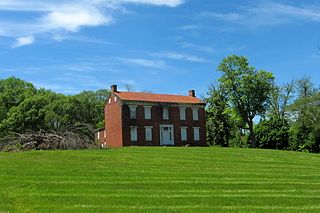
Millbank, also known as Spout Spring and Hillwood, is a historic house at 3100 Berryville Pike, in Frederick County, Virginia east of the city of Winchester. The two story brick mansion was built c. 1850 by Isaac and Daniel T. Wood. It is one of the largest Greek Revival houses in the county, standing on a hill overlooking Berryville Pike and Opequon Creek, which flows east of the property. The house has a typical I-house plan, with two entrances, one facing the highway and one the creek. Both were originally sheltered by Doric-columned porches, but the side entry's porch has been removed by vandals. The house was previously owned by the Winchester-Frederick Service Authority, who took the property in 1984 by eminent domain to construct the adjacent sewage treatment plant. It is now owned by The Fort Collier Civil War Center, Inc. (2014.) This nonprofit organization owns historic Fort Collier, another Third Battle of Winchester site.





















